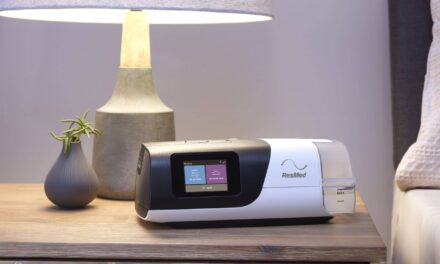For UV light-based cleaners, the FDA’s studies show that the power and time during which CPAP masks and accessories are exposed to this light varies considerably.
Today, the US Food and Drug Administration (FDA) issued a Safety Communication to inform patients and health care providers that devices claiming to clean, disinfect, or sanitize continuous positive airway pressure (CPAP) devices or accessories (such as masks, tubing, and headgear) using ozone gas or ultraviolet (UV) light are not legally marketed for this use by the FDA in the United States, and as such, their safety and effectiveness for use with CPAP devices and accessories is unknown.
To ensure the safe and effective cleaning of CPAP devices and accessories, the FDA is recommending that consumers and health care providers follow the cleaning instructions provided by the CPAP’s manufacturer, which normally include regular cleaning with soap and water.
“The FDA has identified several manufacturers that are marketing ozone gas or UV light-based products claiming to clean, disinfect, or sanitize CPAP devices and accessories in the home,” says William H. Maisel, MD, MPH, director of the Office of Product Evaluation and Quality in the FDA’s Center for Devices and Radiological Health, in a release. “Exposure to high levels of ozone gas may worsen a patient’s existing chronic respiratory diseases or increase the chance of a respiratory infection. UV light-based products could cause burns, eye damage, or increase the risk of skin cancer due to overexposure. The FDA has contacted manufacturers of products making these claims and asked them to submit data demonstrating their safety and effectiveness.”
The FDA has received 11 reports from 2017-2019 from patients experiencing cough, difficult breathing, nasal irritation, headaches, asthma attacks, and other breathing complaints when ozone gas-based products were used to clean, sanitize, or disinfect CPAP devices and accessories. The FDA has not received any adverse event reports for UV light products claiming to clean, disinfect, or sanitize CPAP devices and accessories.
Ozone is a gas that can be used to kill harmful bacteria. However, for ozone to be effective in killing harmful bacteria, it must be present at a concentration far greater than what is considered safe for humans. Although products claiming to clean, disinfect, or sanitize CPAP devices that use ozone gas claim to be designed to keep ozone gas inside the machine and its accessories, leaks can occur at tubing connections, filters, or through containers used to house CPAP accessories. When leaks occur, ozone gas in the room where the devices are used may temporarily rise to unsafe levels especially if the room is small or not well ventilated.
What’s more, if the CPAP machine or accessories are used without first allowing fresh air to circulate through the entire CPAP system to remove any remaining ozone gas, this could lead to someone inhaling ozone, which could cause breathing problems.
Direct exposure to UV light may cause injury depending on its wavelength, intensity, and exposure time. Additionally, the UV light may not be able to penetrate all components of CPAP devices and accessories, like the plastic tubing, masks, and connectors, which could lead to inadequately disinfected components that may be unsafe for people to reuse.
While these devices claiming to clean, sanitize, or disinfect CPAP machines and accessories have not been FDA cleared or approved for marketing in the United States, the FDA conducted its own preliminary lab testing on several of those illegally marketed products.
The testing demonstrated ozone-using disinfection devices generated ambient levels of ozone above limits considered safe for human exposure. Ozone levels were also high in CPAP machines and tubing even after waiting the amount of time recommended by the device manufacturer after a cleaning cycle.
The FDA’s studies also showed the power of the UV light and time during which CPAP masks and accessories were exposed to this light varied considerably among UV cleaners. If CPAP components are exposed to insufficiently strong UV light or processed for an insufficient amount of time, the CPAP components could be inadequately disinfected leading to safety and performance issues.
The FDA has contacted manufacturers of the ozone gas and UV light products that claim to clean, sanitize, or disinfect CPAP devices and accessories. Each manufacturer was informed that based on their product’s intended use and technological characteristics, FDA review and clearance or approval is needed and that data would need to be provided to demonstrate safety and effectiveness.
CPAP cleaner marketer SoClean says in an emailed statement, “As noted in FDA’s alert, the agency reached out to the industry last year. SoClean has been working cooperatively with the FDA and is fully committed to operating in full compliance with FDA’s requirements. Through these efforts, which include providing FDA with extensive testing data, and having a meeting with agency representatives, the company will ensure its number-one position in this category now and set the standard for performance in the industry.”
No other CPAP cleaner companies have responded to Sleep Review‘s request for comment at this time.
The FDA will continue to monitor reports of adverse events associated with the use of ozone gas or UV-based devices that claim to clean, sanitize, or disinfect CPAP devices and accessories and update the public should new information become available.
The FDA encourages individuals to report adverse events related to the use of these devices to the FDA.
Updated 3/4/20 with statement from SoClean.

![FDA Preliminary Lab Tests: Several CPAP Cleaners Generate Ambient Levels of Ozone Above Safe Limits [Video]](https://sleepreviewmag.com/wp-content/uploads/2020/03/ozone-cpap-cleaners-1280x640.jpg)

